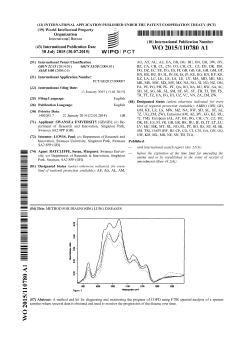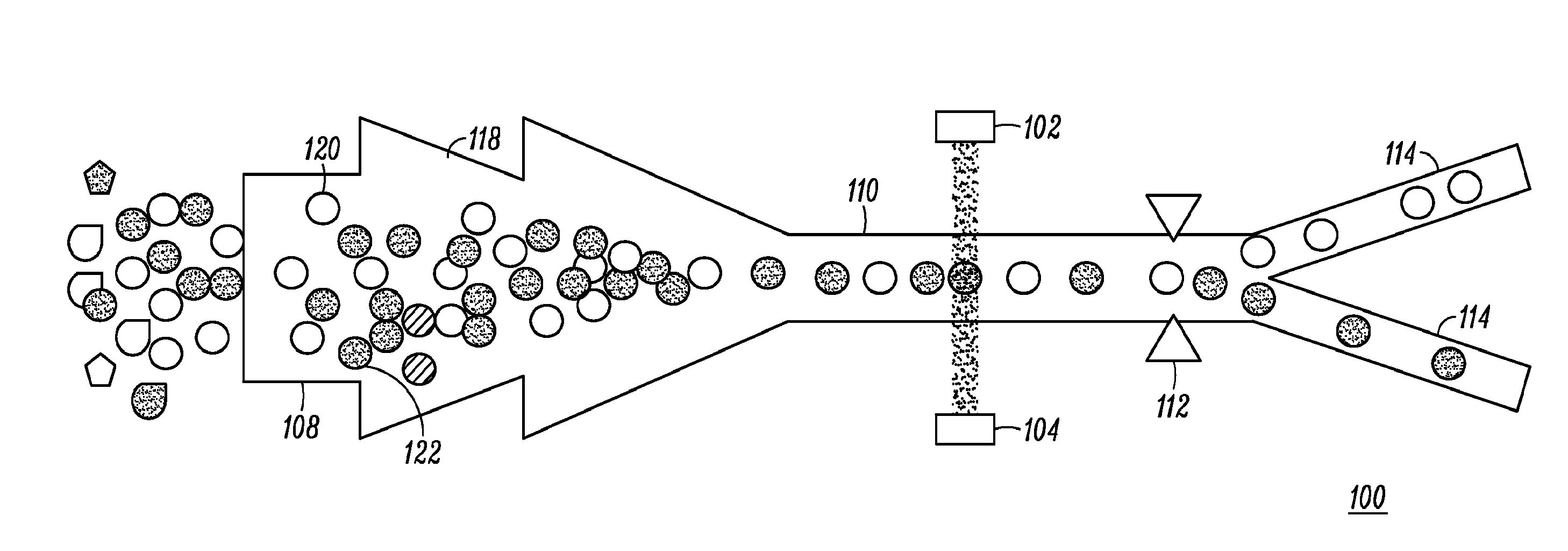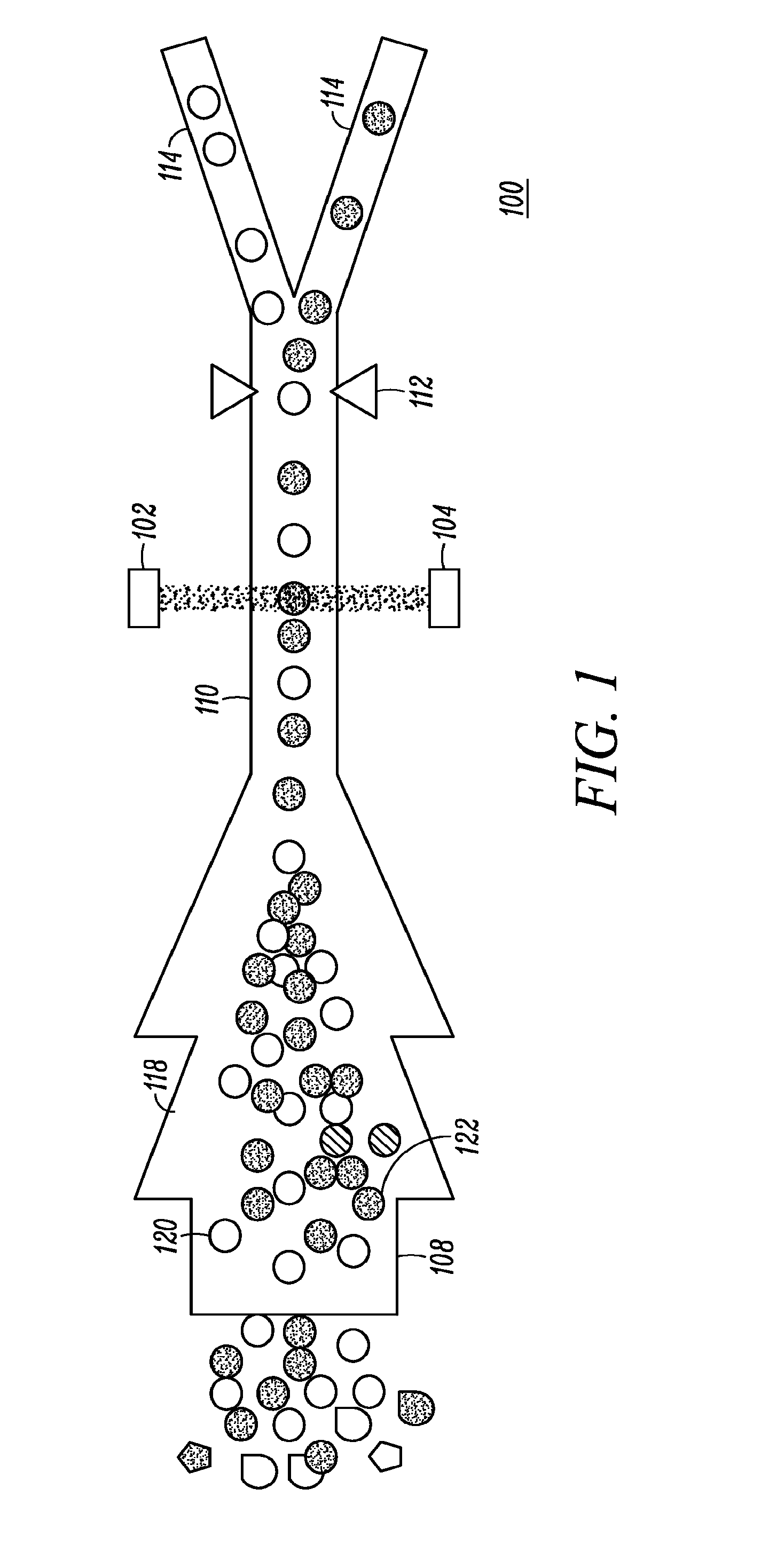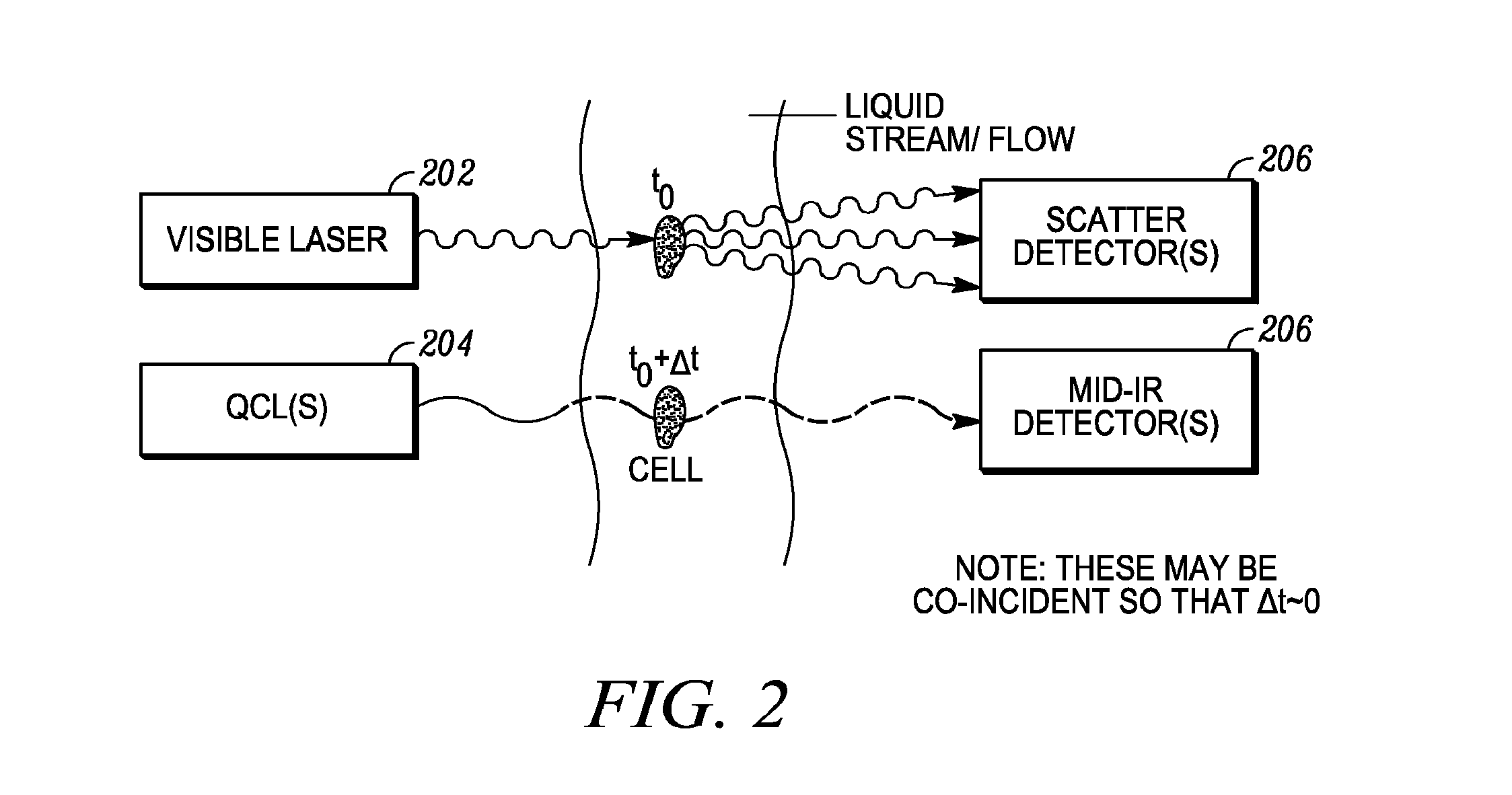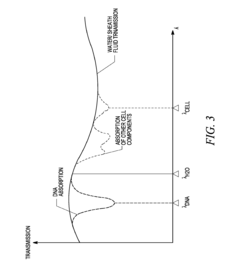FTIR Imaging vs Spectroscopy: Applications & Limits
SEP 22, 20259 MIN READ
Generate Your Research Report Instantly with AI Agent
Patsnap Eureka helps you evaluate technical feasibility & market potential.
FTIR Technology Background and Objectives
Fourier Transform Infrared (FTIR) spectroscopy has evolved significantly since its inception in the mid-20th century, transforming from a specialized analytical technique to an essential tool across multiple scientific disciplines. The technology leverages the interaction between infrared radiation and matter, allowing researchers to identify molecular structures and chemical compositions based on the absorption patterns of infrared light.
The evolution of FTIR technology has been marked by several key advancements. Initially developed as a single-point spectroscopic method, FTIR has expanded to include imaging capabilities, enabling spatial distribution analysis of chemical components across samples. This transition from purely spectroscopic applications to imaging represents a fundamental shift in the technology's utility and application scope.
FTIR spectroscopy focuses on obtaining detailed spectral information from specific sample points, providing high spectral resolution and sensitivity for molecular identification and quantification. In contrast, FTIR imaging captures spectral data across an entire sample area simultaneously, generating chemical distribution maps that reveal spatial heterogeneity within samples.
The primary objective of modern FTIR technology development is to balance the inherent trade-offs between spectroscopy and imaging approaches. Spectroscopic methods prioritize spectral resolution and sensitivity, while imaging techniques emphasize spatial information and throughput. Current research aims to overcome these limitations through innovations in instrumentation, data processing algorithms, and integration with complementary analytical techniques.
Recent technological trends include the miniaturization of FTIR systems, development of portable devices, integration with artificial intelligence for data interpretation, and combination with other imaging modalities for multimodal analysis. These advancements are expanding FTIR applications beyond traditional laboratory settings into field-deployable solutions for environmental monitoring, medical diagnostics, and industrial quality control.
The convergence of spectroscopy and imaging capabilities represents the frontier of FTIR technology development. Researchers are actively pursuing methods to achieve high spatial resolution without sacrificing spectral quality, as well as increasing acquisition speeds to enable dynamic process monitoring. These efforts aim to transform FTIR from a primarily analytical tool into a comprehensive platform for both qualitative and quantitative chemical analysis with spatial context.
Understanding the fundamental principles, historical development, and current technological objectives of FTIR is essential for evaluating its applications and limitations in various fields, from biomedical research and pharmaceutical development to materials science and environmental analysis.
The evolution of FTIR technology has been marked by several key advancements. Initially developed as a single-point spectroscopic method, FTIR has expanded to include imaging capabilities, enabling spatial distribution analysis of chemical components across samples. This transition from purely spectroscopic applications to imaging represents a fundamental shift in the technology's utility and application scope.
FTIR spectroscopy focuses on obtaining detailed spectral information from specific sample points, providing high spectral resolution and sensitivity for molecular identification and quantification. In contrast, FTIR imaging captures spectral data across an entire sample area simultaneously, generating chemical distribution maps that reveal spatial heterogeneity within samples.
The primary objective of modern FTIR technology development is to balance the inherent trade-offs between spectroscopy and imaging approaches. Spectroscopic methods prioritize spectral resolution and sensitivity, while imaging techniques emphasize spatial information and throughput. Current research aims to overcome these limitations through innovations in instrumentation, data processing algorithms, and integration with complementary analytical techniques.
Recent technological trends include the miniaturization of FTIR systems, development of portable devices, integration with artificial intelligence for data interpretation, and combination with other imaging modalities for multimodal analysis. These advancements are expanding FTIR applications beyond traditional laboratory settings into field-deployable solutions for environmental monitoring, medical diagnostics, and industrial quality control.
The convergence of spectroscopy and imaging capabilities represents the frontier of FTIR technology development. Researchers are actively pursuing methods to achieve high spatial resolution without sacrificing spectral quality, as well as increasing acquisition speeds to enable dynamic process monitoring. These efforts aim to transform FTIR from a primarily analytical tool into a comprehensive platform for both qualitative and quantitative chemical analysis with spatial context.
Understanding the fundamental principles, historical development, and current technological objectives of FTIR is essential for evaluating its applications and limitations in various fields, from biomedical research and pharmaceutical development to materials science and environmental analysis.
Market Applications and Industry Demand
The FTIR imaging and spectroscopy market has experienced significant growth driven by increasing demand across multiple industries. The pharmaceutical sector represents one of the largest application areas, utilizing these technologies for drug development, quality control, and formulation analysis. Pharmaceutical companies leverage FTIR capabilities to identify chemical compositions, detect impurities, and ensure batch-to-batch consistency in manufacturing processes.
Healthcare applications constitute another substantial market segment, with FTIR technologies being employed in disease diagnosis, tissue analysis, and biomedical research. The ability to detect molecular changes associated with pathological conditions makes FTIR particularly valuable in clinical settings. Hospitals and diagnostic laboratories are increasingly adopting these technologies to enhance their analytical capabilities and improve patient outcomes.
The materials science and polymer industries represent growing markets for FTIR technologies. Researchers and manufacturers utilize these techniques to characterize new materials, analyze polymer compositions, and investigate structural properties. The automotive and aerospace sectors specifically employ FTIR for quality control of components and failure analysis investigations.
Environmental monitoring applications have shown accelerated growth, with FTIR technologies being deployed for air quality assessment, water contamination detection, and soil analysis. Regulatory agencies and environmental consulting firms rely on these technologies to ensure compliance with increasingly stringent environmental standards and regulations.
Food and agriculture industries have also embraced FTIR technologies for quality control, authenticity verification, and contamination detection. Food manufacturers utilize these techniques to analyze nutritional content, detect adulterants, and ensure product consistency across production batches.
Market analysis indicates that FTIR imaging systems command premium pricing compared to conventional spectroscopy equipment due to their advanced capabilities and broader application potential. The global market for FTIR technologies was valued at several billion dollars in 2022, with projected annual growth rates exceeding the average for analytical instrumentation markets.
Regional demand patterns show North America and Europe as leading markets, primarily driven by pharmaceutical and healthcare applications. However, the Asia-Pacific region demonstrates the fastest growth trajectory, fueled by expanding industrial bases, increasing R&D investments, and growing environmental concerns in countries like China, Japan, and India.
Healthcare applications constitute another substantial market segment, with FTIR technologies being employed in disease diagnosis, tissue analysis, and biomedical research. The ability to detect molecular changes associated with pathological conditions makes FTIR particularly valuable in clinical settings. Hospitals and diagnostic laboratories are increasingly adopting these technologies to enhance their analytical capabilities and improve patient outcomes.
The materials science and polymer industries represent growing markets for FTIR technologies. Researchers and manufacturers utilize these techniques to characterize new materials, analyze polymer compositions, and investigate structural properties. The automotive and aerospace sectors specifically employ FTIR for quality control of components and failure analysis investigations.
Environmental monitoring applications have shown accelerated growth, with FTIR technologies being deployed for air quality assessment, water contamination detection, and soil analysis. Regulatory agencies and environmental consulting firms rely on these technologies to ensure compliance with increasingly stringent environmental standards and regulations.
Food and agriculture industries have also embraced FTIR technologies for quality control, authenticity verification, and contamination detection. Food manufacturers utilize these techniques to analyze nutritional content, detect adulterants, and ensure product consistency across production batches.
Market analysis indicates that FTIR imaging systems command premium pricing compared to conventional spectroscopy equipment due to their advanced capabilities and broader application potential. The global market for FTIR technologies was valued at several billion dollars in 2022, with projected annual growth rates exceeding the average for analytical instrumentation markets.
Regional demand patterns show North America and Europe as leading markets, primarily driven by pharmaceutical and healthcare applications. However, the Asia-Pacific region demonstrates the fastest growth trajectory, fueled by expanding industrial bases, increasing R&D investments, and growing environmental concerns in countries like China, Japan, and India.
Current Technical Limitations and Challenges
Despite significant advancements in FTIR technology, both imaging and spectroscopy techniques face substantial limitations that impact their practical applications. The spatial resolution of FTIR imaging remains fundamentally constrained by the diffraction limit, typically restricting resolution to 3-10 μm depending on the wavelength used. This limitation becomes particularly problematic when analyzing heterogeneous samples with sub-micron features, such as cellular components or nanomaterials.
Temporal resolution presents another significant challenge, especially for FTIR imaging. The acquisition of high-quality hyperspectral data cubes can require several minutes to hours, making real-time monitoring of dynamic processes virtually impossible. This temporal constraint severely limits applications in reaction monitoring, biological processes observation, and industrial quality control where rapid assessment is essential.
Signal-to-noise ratio (SNR) issues persist in both techniques but manifest differently. In FTIR spectroscopy, SNR can be improved through multiple scans, but at the cost of extended acquisition times. For FTIR imaging, the trade-off becomes more complex as improving SNR for an entire image dataset exponentially increases collection time, creating a practical ceiling for data quality in time-sensitive applications.
Sample preparation requirements introduce additional complications. Both techniques typically require thin, uniform samples for optimal results. Thick or highly absorbing samples often produce spectral distortions due to non-linear absorption effects. Water strongly absorbs in the mid-IR region, necessitating dehydration or special sample handling for biological specimens, potentially altering their native state.
Computational and data management challenges are particularly acute for FTIR imaging. A single hyperspectral dataset can reach several gigabytes, requiring substantial computational resources for processing and analysis. The development of efficient algorithms for spectral unmixing, background correction, and feature extraction remains an active research area with significant room for improvement.
Instrumentation costs represent a practical barrier to widespread adoption. High-resolution FTIR imaging systems with focal plane array detectors can cost several hundred thousand dollars, limiting accessibility for many research institutions and industrial applications. Maintenance requirements and specialized expertise needed for operation further increase the total cost of ownership.
Quantitative analysis faces challenges in both techniques due to matrix effects, sample heterogeneity, and the complex relationship between spectral features and analyte concentration. Calibration models often require extensive validation and may not transfer well between different sample types or instrumental setups.
Temporal resolution presents another significant challenge, especially for FTIR imaging. The acquisition of high-quality hyperspectral data cubes can require several minutes to hours, making real-time monitoring of dynamic processes virtually impossible. This temporal constraint severely limits applications in reaction monitoring, biological processes observation, and industrial quality control where rapid assessment is essential.
Signal-to-noise ratio (SNR) issues persist in both techniques but manifest differently. In FTIR spectroscopy, SNR can be improved through multiple scans, but at the cost of extended acquisition times. For FTIR imaging, the trade-off becomes more complex as improving SNR for an entire image dataset exponentially increases collection time, creating a practical ceiling for data quality in time-sensitive applications.
Sample preparation requirements introduce additional complications. Both techniques typically require thin, uniform samples for optimal results. Thick or highly absorbing samples often produce spectral distortions due to non-linear absorption effects. Water strongly absorbs in the mid-IR region, necessitating dehydration or special sample handling for biological specimens, potentially altering their native state.
Computational and data management challenges are particularly acute for FTIR imaging. A single hyperspectral dataset can reach several gigabytes, requiring substantial computational resources for processing and analysis. The development of efficient algorithms for spectral unmixing, background correction, and feature extraction remains an active research area with significant room for improvement.
Instrumentation costs represent a practical barrier to widespread adoption. High-resolution FTIR imaging systems with focal plane array detectors can cost several hundred thousand dollars, limiting accessibility for many research institutions and industrial applications. Maintenance requirements and specialized expertise needed for operation further increase the total cost of ownership.
Quantitative analysis faces challenges in both techniques due to matrix effects, sample heterogeneity, and the complex relationship between spectral features and analyte concentration. Calibration models often require extensive validation and may not transfer well between different sample types or instrumental setups.
Comparative Analysis of FTIR Methodologies
01 High-resolution FTIR imaging techniques
Advanced FTIR imaging systems that achieve superior spatial resolution through innovative optical designs and detector technologies. These systems enable detailed chemical mapping of samples with microscopic precision, allowing researchers to identify and analyze chemical components at the cellular or subcellular level. High-resolution FTIR imaging is particularly valuable in biomedical research, materials science, and pharmaceutical development where detailed spatial information about chemical composition is critical.- High-resolution FTIR imaging techniques: Advanced FTIR imaging techniques have been developed to achieve higher spatial resolution, which is crucial for detailed analysis of complex samples. These techniques include the use of specialized optics, computational algorithms, and novel detector arrays that can overcome traditional diffraction limits. High-resolution FTIR imaging enables the visualization of chemical distributions at microscopic scales, allowing for more precise characterization of heterogeneous materials and biological tissues.
- Enhanced sensitivity in FTIR spectroscopy: Innovations in FTIR spectroscopy have significantly improved detection sensitivity, allowing for analysis of trace components and low-concentration analytes. These advancements include improved detector technologies, signal processing methods, and sample preparation techniques. Enhanced sensitivity is achieved through noise reduction strategies, optical path optimization, and integration of pre-concentration methods, enabling the detection of substances at parts-per-billion levels in various applications including environmental monitoring and pharmaceutical analysis.
- Rapid data acquisition systems for FTIR: Accelerated data acquisition systems have revolutionized FTIR spectroscopy by reducing scanning times from minutes to seconds or even milliseconds. These systems employ high-speed interferometers, advanced electronics, and parallel processing capabilities to capture spectral information rapidly. Fast data acquisition enables real-time monitoring of dynamic processes, high-throughput screening applications, and the analysis of time-sensitive reactions, significantly expanding the utility of FTIR in industrial process control and research applications.
- Portable and miniaturized FTIR devices: Miniaturization of FTIR technology has led to the development of portable, field-deployable spectroscopic systems that maintain reasonable resolution and sensitivity. These compact devices integrate micro-electromechanical systems (MEMS), specialized optical components, and efficient power management to deliver laboratory-quality analysis in field settings. Portable FTIR systems enable on-site analysis for environmental monitoring, forensic investigations, and quality control applications, eliminating the need for sample transport to centralized laboratories.
- Hyperspectral FTIR imaging advancements: Hyperspectral FTIR imaging combines spatial and spectral information to create comprehensive chemical maps of samples. Recent advancements include improved data processing algorithms, faster scanning mechanisms, and integration with machine learning for automated analysis. These systems can simultaneously collect thousands of spectra across a sample area, providing detailed chemical composition information with spatial context. Applications include pharmaceutical quality control, biomedical diagnostics, and materials characterization where both chemical identity and distribution are important.
02 Enhanced sensitivity in FTIR spectroscopy
Innovations that improve the signal-to-noise ratio and detection limits in FTIR spectroscopy. These advancements include improved detector technologies, signal processing algorithms, and optical configurations that maximize the collection of infrared radiation. Enhanced sensitivity allows for the detection of trace compounds and subtle chemical changes that would be undetectable with conventional systems, expanding the application range of FTIR spectroscopy to fields requiring high analytical sensitivity such as environmental monitoring and forensic analysis.Expand Specific Solutions03 Rapid data acquisition systems for FTIR
Technologies that significantly increase the speed of FTIR data collection without compromising spectral quality. These systems employ fast-scanning interferometers, parallel processing capabilities, and optimized data handling protocols to reduce acquisition times from minutes to seconds or even milliseconds. Rapid data acquisition is essential for time-resolved studies, high-throughput screening applications, and real-time process monitoring where chemical changes need to be tracked dynamically.Expand Specific Solutions04 Portable and miniaturized FTIR devices
Compact FTIR systems designed for field use and point-of-care applications. These devices integrate miniaturized optical components, robust design features, and battery operation to enable spectroscopic analysis outside of traditional laboratory settings. Portable FTIR technology brings analytical capabilities to remote locations, enabling on-site testing for environmental monitoring, food safety inspection, pharmaceutical verification, and geological surveys without sample transportation to centralized facilities.Expand Specific Solutions05 Advanced data processing for FTIR spectroscopy
Sophisticated algorithms and computational methods that enhance the extraction of information from FTIR spectral data. These approaches include chemometric analysis, machine learning techniques, and automated spectral interpretation tools that can identify patterns, classify samples, and quantify components with greater accuracy than conventional analysis methods. Advanced data processing extends the capabilities of FTIR spectroscopy by enabling more complex analyses and reducing the expertise required for spectral interpretation.Expand Specific Solutions
Leading Manufacturers and Research Institutions
FTIR Imaging and Spectroscopy technology is currently in a growth phase, with increasing applications across biomedical, materials science, and environmental sectors. The market is expanding steadily, estimated to reach significant value as analytical techniques become more sophisticated. In terms of technological maturity, established players like Agilent Technologies and Daylight Solutions offer commercial solutions with advanced capabilities, while academic institutions such as MIT, University of Liverpool, and Max Planck Society drive fundamental research innovations. Emerging companies like Photothermal Spectroscopy Corp. and Dxcover Ltd. are developing specialized applications, particularly in medical diagnostics. The competitive landscape shows a mix of large instrumentation companies, specialized startups, and research institutions collaborating to overcome current limitations in spatial resolution, sensitivity, and data processing capabilities.
Photothermal Spectroscopy Corp.
Technical Solution: Photothermal Spectroscopy Corp. has pioneered a hybrid approach that bridges FTIR imaging and spectroscopy through their patented Optical Photothermal Infrared (O-PTIR) technology. This innovative solution combines the benefits of both techniques by using a visible probe laser to detect photothermal expansion caused by infrared absorption. The technology enables submicron spatial resolution (down to ~500 nm) that significantly exceeds the diffraction limit of conventional FTIR imaging. Their mIRage system can perform non-contact analysis without special sample preparation and works effectively with aqueous samples that traditionally challenge conventional FTIR. The company has developed specialized applications for polymer blend analysis, where their technology can map component distribution at interfaces with unprecedented detail, and for biological tissue analysis, where the submicron resolution allows examination of subcellular structures. Their systems also feature simultaneous Raman spectroscopy capabilities, providing complementary molecular information from the same sampling point.
Strengths: Breakthrough submicron spatial resolution exceeding traditional FTIR limits; non-destructive analysis requiring minimal sample preparation; effective with challenging samples including aqueous solutions. Weaknesses: Relatively new technology with smaller installed base; higher initial investment compared to conventional FTIR; more complex data interpretation requiring specialized expertise.
Daylight Solutions, Inc.
Technical Solution: Daylight Solutions has developed quantum cascade laser (QCL) based mid-infrared spectroscopy and imaging systems that represent a significant departure from traditional FTIR approaches. Their Spero-QT platform utilizes tunable QCL technology to deliver high-brightness, narrowband infrared illumination across the fingerprint region (900-1800 cm⁻¹). This approach enables rapid, label-free chemical imaging with diffraction-limited spatial resolution and exceptional signal-to-noise ratios. Unlike conventional FTIR systems that require interferometers and moving parts, Daylight's technology employs solid-state QCL arrays that can be electronically tuned across specific wavelength ranges of interest, dramatically increasing acquisition speed for targeted applications. Their systems have demonstrated particular utility in biomedical research, where they can perform real-time histopathology without staining or other sample preparation. The company has also developed specialized applications for pharmaceutical manufacturing, where their technology enables in-line process monitoring with microsecond temporal resolution. Recent advances include machine learning integration for automated tissue classification and disease diagnosis.
Strengths: Superior speed and signal-to-noise ratio compared to traditional FTIR; no moving parts leading to greater reliability; exceptional brightness enabling rapid imaging of large sample areas. Weaknesses: More limited spectral range than full FTIR systems; higher initial cost; requires more sophisticated cooling systems for the QCL sources.
Key Patents and Scientific Breakthroughs
Method for diagnosing lung diseases
PatentPendingHK1231170A
Innovation
- The use of Fourier Transform Infrared Spectroscopy (FTIR) and Variable Filter Infrared Spectroscopy (VFIR) to analyze sputum samples, comparing spectral profiles within specific wavenumber ranges to identify COPD progression and risk of exacerbations, providing a non-invasive and practical diagnostic method.
Cytometry system with interferometric measurement
PatentActiveUS20160282264A1
Innovation
- A cytometry system utilizing a quantum cascade laser (QCL) for mid-infrared light to measure cells with reduced scattering and energy, allowing for accurate chemical composition analysis and sorting without labels or dyes, using multiple wavelengths to differentiate cell characteristics like size, shape, and chemical content, and employing interferometric spectroscopy for improved signal-to-noise ratio.
Resolution and Sensitivity Trade-offs
The fundamental trade-off between resolution and sensitivity represents one of the most critical considerations when comparing FTIR imaging and spectroscopy technologies. In FTIR imaging, spatial resolution is typically limited to 3-10 μm due to diffraction limits at mid-infrared wavelengths, while spectroscopy can achieve spectral resolutions down to 0.1 cm⁻¹. This inherent inverse relationship means that improvements in one parameter often come at the expense of the other.
When operating FTIR imaging systems, researchers must carefully balance acquisition time against signal quality. Higher spatial resolution requires smaller apertures or more sophisticated optics, which inevitably reduces the signal-to-noise ratio (SNR). Conversely, FTIR spectroscopy prioritizes spectral detail but sacrifices spatial information, allowing for enhanced sensitivity to subtle chemical variations within samples.
Recent technological advancements have attempted to address these limitations through various approaches. Synchrotron-based FTIR imaging can achieve sub-micron spatial resolution while maintaining acceptable sensitivity levels, though at significantly increased cost and reduced accessibility. Similarly, quantum cascade laser (QCL) sources have emerged as promising alternatives, offering higher brightness that improves SNR at higher spatial resolutions.
The practical implications of these trade-offs manifest differently across application domains. In biomedical applications, researchers often require sufficient spatial resolution to distinguish cellular components (typically 5-10 μm) while maintaining sensitivity to detect low-concentration biomolecules. Environmental monitoring applications may prioritize sensitivity to detect trace contaminants, while materials science might demand higher spatial resolution to characterize heterogeneous structures.
Mathematical modeling suggests that the resolution-sensitivity relationship follows approximately an inverse square law, where doubling the spatial resolution reduces sensitivity by a factor of four. This relationship becomes particularly problematic when analyzing samples with inherently weak infrared absorption or when investigating trace components within complex matrices.
Emerging computational approaches offer promising pathways to partially overcome these physical limitations. Super-resolution techniques, multivariate analysis, and machine learning algorithms can extract additional information from existing datasets, effectively enhancing both resolution and sensitivity through post-processing. However, these approaches cannot fundamentally overcome the physical constraints imposed by diffraction limits and detector noise floors.
The ultimate selection between prioritizing resolution or sensitivity depends heavily on the specific research question, sample characteristics, and analytical requirements. Understanding these trade-offs is essential for designing appropriate experimental protocols and interpreting results accurately within the inherent constraints of FTIR technologies.
When operating FTIR imaging systems, researchers must carefully balance acquisition time against signal quality. Higher spatial resolution requires smaller apertures or more sophisticated optics, which inevitably reduces the signal-to-noise ratio (SNR). Conversely, FTIR spectroscopy prioritizes spectral detail but sacrifices spatial information, allowing for enhanced sensitivity to subtle chemical variations within samples.
Recent technological advancements have attempted to address these limitations through various approaches. Synchrotron-based FTIR imaging can achieve sub-micron spatial resolution while maintaining acceptable sensitivity levels, though at significantly increased cost and reduced accessibility. Similarly, quantum cascade laser (QCL) sources have emerged as promising alternatives, offering higher brightness that improves SNR at higher spatial resolutions.
The practical implications of these trade-offs manifest differently across application domains. In biomedical applications, researchers often require sufficient spatial resolution to distinguish cellular components (typically 5-10 μm) while maintaining sensitivity to detect low-concentration biomolecules. Environmental monitoring applications may prioritize sensitivity to detect trace contaminants, while materials science might demand higher spatial resolution to characterize heterogeneous structures.
Mathematical modeling suggests that the resolution-sensitivity relationship follows approximately an inverse square law, where doubling the spatial resolution reduces sensitivity by a factor of four. This relationship becomes particularly problematic when analyzing samples with inherently weak infrared absorption or when investigating trace components within complex matrices.
Emerging computational approaches offer promising pathways to partially overcome these physical limitations. Super-resolution techniques, multivariate analysis, and machine learning algorithms can extract additional information from existing datasets, effectively enhancing both resolution and sensitivity through post-processing. However, these approaches cannot fundamentally overcome the physical constraints imposed by diffraction limits and detector noise floors.
The ultimate selection between prioritizing resolution or sensitivity depends heavily on the specific research question, sample characteristics, and analytical requirements. Understanding these trade-offs is essential for designing appropriate experimental protocols and interpreting results accurately within the inherent constraints of FTIR technologies.
Sample Preparation Requirements
Sample preparation is a critical factor that significantly influences the quality and reliability of both FTIR imaging and spectroscopy analyses. For FTIR spectroscopy, samples typically require minimal preparation when analyzing liquids or gases, often utilizing specialized cells with infrared-transparent windows made of materials such as calcium fluoride, zinc selenide, or potassium bromide. Solid samples generally necessitate more extensive preparation, commonly involving grinding with potassium bromide and pressing into pellets to create a transparent medium for infrared transmission.
In contrast, FTIR imaging imposes more stringent sample preparation requirements due to its spatial resolution capabilities. Samples must be uniformly thin (typically 5-15 μm) to allow sufficient infrared transmission while maintaining spatial integrity. This often necessitates microtoming techniques for solid samples or specialized sample holders for maintaining consistent thickness in liquid samples. The preparation of biological tissues for FTIR imaging frequently involves fixation, embedding, and sectioning processes that must preserve both chemical composition and morphological features.
Surface cleanliness represents another crucial aspect of sample preparation for both techniques. Contaminants can produce misleading spectral features that compromise data interpretation. This concern is particularly pronounced in FTIR imaging, where spatial resolution can be affected by surface irregularities or contamination gradients across the sample area.
Environmental conditions during sample preparation also warrant careful consideration. Atmospheric water vapor and carbon dioxide can introduce interfering spectral bands, necessitating controlled environments during preparation and analysis. Some hygroscopic samples may require handling in dry atmospheres to prevent moisture absorption that could alter their chemical composition or physical structure.
The choice of substrate materials presents additional challenges, especially for FTIR imaging in reflectance mode. Substrates must be IR-reflective or transparent depending on the measurement configuration, with materials like gold-coated slides, barium fluoride, or calcium fluoride windows commonly employed. These materials can be costly and require careful handling to prevent damage that might compromise optical properties.
For quantitative analyses using either technique, sample thickness uniformity becomes particularly critical. Variations in sample thickness can lead to non-linear absorbance effects that complicate quantitative interpretation. This challenge is magnified in FTIR imaging, where thickness variations across the imaged area can create artifacts that may be misinterpreted as chemical heterogeneity.
In contrast, FTIR imaging imposes more stringent sample preparation requirements due to its spatial resolution capabilities. Samples must be uniformly thin (typically 5-15 μm) to allow sufficient infrared transmission while maintaining spatial integrity. This often necessitates microtoming techniques for solid samples or specialized sample holders for maintaining consistent thickness in liquid samples. The preparation of biological tissues for FTIR imaging frequently involves fixation, embedding, and sectioning processes that must preserve both chemical composition and morphological features.
Surface cleanliness represents another crucial aspect of sample preparation for both techniques. Contaminants can produce misleading spectral features that compromise data interpretation. This concern is particularly pronounced in FTIR imaging, where spatial resolution can be affected by surface irregularities or contamination gradients across the sample area.
Environmental conditions during sample preparation also warrant careful consideration. Atmospheric water vapor and carbon dioxide can introduce interfering spectral bands, necessitating controlled environments during preparation and analysis. Some hygroscopic samples may require handling in dry atmospheres to prevent moisture absorption that could alter their chemical composition or physical structure.
The choice of substrate materials presents additional challenges, especially for FTIR imaging in reflectance mode. Substrates must be IR-reflective or transparent depending on the measurement configuration, with materials like gold-coated slides, barium fluoride, or calcium fluoride windows commonly employed. These materials can be costly and require careful handling to prevent damage that might compromise optical properties.
For quantitative analyses using either technique, sample thickness uniformity becomes particularly critical. Variations in sample thickness can lead to non-linear absorbance effects that complicate quantitative interpretation. This challenge is magnified in FTIR imaging, where thickness variations across the imaged area can create artifacts that may be misinterpreted as chemical heterogeneity.
Unlock deeper insights with Patsnap Eureka Quick Research — get a full tech report to explore trends and direct your research. Try now!
Generate Your Research Report Instantly with AI Agent
Supercharge your innovation with Patsnap Eureka AI Agent Platform!
